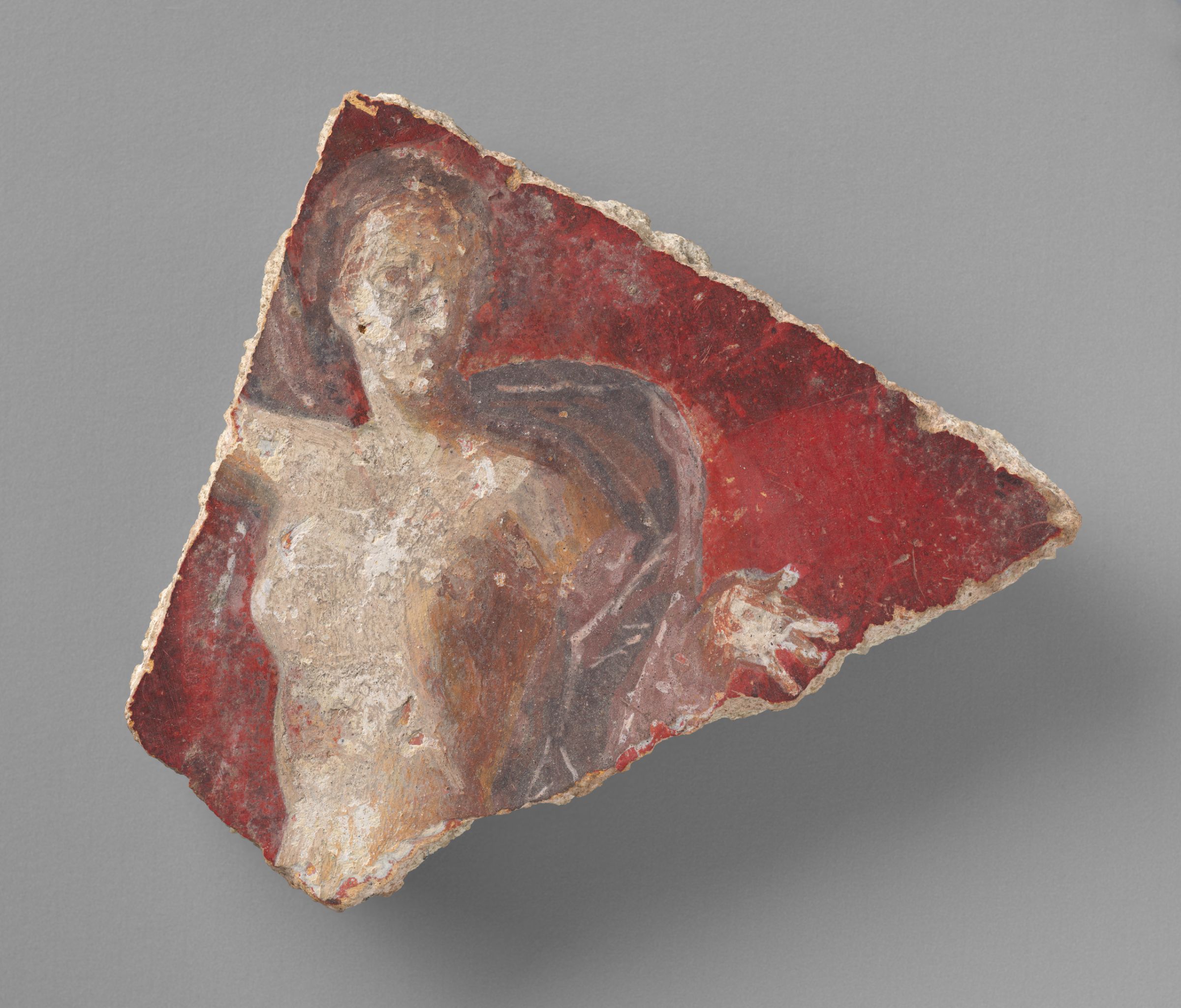1992.256.84: Mercury
SculptureIdentification and Creation
- Object Number
- 1992.256.84
- Title
- Mercury
- Classification
- Sculpture
- Work Type
- statuette, sculpture
- Date
- 1st-3rd century CE
- Places
- Creation Place: Ancient & Byzantine World, Asia, Anatolia
- Period
- Roman Imperial period
- Culture
- Roman
- Persistent Link
- https://hvrd.art/o/311851
Physical Descriptions
- Medium
- Leaded bronze
- Technique
- Cast, lost-wax process
- Dimensions
- 4.8 x 3 x 1.1 cm (1 7/8 x 1 3/16 x 7/16 in.)
- Technical Details
-
Chemical Composition: ICP-MS/AAA data from sample, Leaded Bronze:
Cu, 66.13; Sn, 6.64; Pb, 26.26; Zn, 0.293; Fe, 0.28; Ni, 0.04; Ag, 0.04; Sb, 0.08; As, 0.22; Bi, less than 0.025; Co, 0.014; Au, less than 0.01; Cd, less than 0.001
J. RiedererTechnical Observations: The patina is pitted and uneven black and green. The feet are missing; the surface is poorly preserved, and there has been loss of surface detail. The figurine was solid cast, probably by lost-wax casting.
Carol Snow (submitted 2002)
Provenance
- Recorded Ownership History
- Louise M. and George E. Bates, Camden, ME (by 1971-1992), gift; to the Harvard University Art Museums, 1992.
Acquisition and Rights
- Credit Line
- Harvard Art Museums/Arthur M. Sackler Museum, Gift of Louise M. and George E. Bates
- Accession Year
- 1992
- Object Number
- 1992.256.84
- Division
- Asian and Mediterranean Art
- Contact
- am_asianmediterranean@harvard.edu
- Permissions
-
The Harvard Art Museums encourage the use of images found on this website for personal, noncommercial use, including educational and scholarly purposes. To request a higher resolution file of this image, please submit an online request.
Descriptions
Published Catalogue Text: Ancient Mediterranean and Near Eastern Bronzes at the Harvard Art Museums
Known as Mercury to the Romans, the statuette depicts a version of the Greek god Hermes Agoraios (“Hermes of the marketplace”), a patron of commerce who brings wealth and good luck. In the extended right hand, the figure holds a moneybag, a marsuppium, suggesting that the image could provide prosperity to its ancient owner. Cradled upright in the left arm is a herald’s staff, a caduceus, which, along with a winged traveler’s hat, identifies Mercury in his role as messenger of the gods. The god is nude except for a cloak draped from the shoulders and across the chest, called a chlamys. The missing lower legs would have attached the free-standing figure to a pedestal or cylindrical base.
In the Roman household, statuettes such as this one were sometimes grouped with other figures of deities in a shrine, called a lararium (1). This form of statuette was produced and reproduced in large numbers, which testifies to the importance of Mercury as purveyor of good fortune, monetary or otherwise. It was so popular that Mercury figures are found throughout the Roman Empire in a wide range of styles from naturalistic, classical figures to more provincial types, such as this example (2).
Although produced during the Roman Imperial period, the statuette is inspired by a major sculptural type originally created around 440 BCE by the Greek artist Polykleitos. It is a small-scale example of the innovative Polykleitan style, which established an approach to the representation of the human figure by incorporating scientific theories of proportion and symmetry. This was demonstrated by the sculptor in his famous treatise on the topic, called the Kanon, and exemplified by his most notable sculpture, the Doryphoros or “Spearbearer” (3).
NOTES:
1. For lararia, see B. Barr-Sharrar, “The Private Use of Small Bronze Sculpture,” in The Fire of Hephaistos, ed. C. Mattusch (Cambridge, MA, 1996) 104-21, esp. 112-13, fig. 19; for statuettes found together in a lararium in the House of the Red Walls at Pompeii, see T. Fröhlich, Lararien und Fassadenbilder in den Vesuvstäten (Heidelberg, 1991) 356-58.
2. For comparative provincial types, see H. Beck, P. C. Bol, and M. Bückling, eds., Polyklet: Der Bildhauer der griechischen Klassik (Mainz, 1990) 661, no. 198; Lexicon Iconographicum Mythologiae Classicae Mercurius no. 43 (although his hat is more like Mercurius no. 41); and P. G. Warden, The Hilprecht Collection of Greek, Italic, and Roman Bronzes in The University of Pennsylvania Museum (Philadelphia, 1997) 33-34, nos. 73-74. For Mercury types, see Beck, Bol and Bückling 1990 (supra) 655-69, nos. 190-98, 201, and 205-206; and A. Kaufmann-Heinimann, Augst und das Gebiet der Colonia Augusta Raurica (Mainz, 1977) 28-30, with bibliography. For further bibliography on figures of Mercury, see U. Höckmann, “Beobachtungen an einigen Merkurstatuetten,” in Toreutik und figürliche Bronzen römischer Zeit: Akten der 6. Tagung über antike Bronzen, ed. U. Gehrig (Berlin, 1980) 130-37; and A. N. Zadoks-Josephus Jitta, “Les attributs favoris de Mercure,” in Bronzes hellénistiques et romains: Actes du Ve Colloque international sur les bronzes antiques, eds. C. Bérard and P. Ducrey (Lausanne, 1979) 177-79.
3. For Polykleitos and his work, see Beck, Bol, and Bückling 1990 (supra 2); and W. G. Moon, ed., Polykleitos, the Doryphoros and Tradition (Madison, 1995).
Aaron J. Paul
Subjects and Contexts
- Roman Domestic Art
- Ancient Bronzes
Related Digital Tours
Verification Level
This record has been reviewed by the curatorial staff but may be incomplete. Our records are frequently revised and enhanced. For more information please contact the Division of Asian and Mediterranean Art at am_asianmediterranean@harvard.edu
